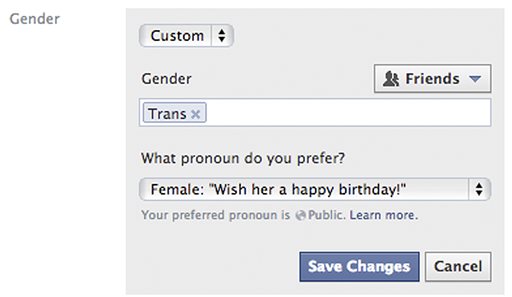You don’t have to be just male or female on Facebook anymore. The social-media giant is adding a customizable option with about 50 different terms people can use to identify their gender as well as three preferred pronoun choices: him, her or them.
Videos by Rare
Facebook said the changes, shared with The Associated Press before the launch on Thursday, initially cover the company’s 159 million monthly users in the U.S. and are aimed at giving people more choices in how they describe themselves, such as androgynous, bi-gender, intersex, gender fluid or transsexual.
“There’s going to be a lot of people for whom this is going to mean nothing, but for the few it does impact, it means the world,” said Facebook software engineer Brielle Harrison, who worked on the project and is herself undergoing gender transformation, from male to female. On Thursday, while watchdogging the software for any problems, she said she was also changing her Facebook identity from Female to TransWoman.
“All too often transgender people like myself and other gender nonconforming people are given this binary option, do you want to be male or female? What is your gender? And it’s kind of disheartening because none of those let us tell others who we really are,” she said. “This really changes that, and for the first time I get to go to the site and specify to all the people I know what my gender is.”
Facebook, which has 1.15 billion active monthly users around the world, also allows them to keep their gender identity private and will continue to do so.
The change to the gender selection option is seen as a major step toward acceptance for people who don’t self-identify as male or female, but the high-profile development seemed senseless to those who believe in two genders, no more.
“Of course Facebook is entitled to manage its wildly popular site as it sees fit, but here is the bottom line: It’s impossible to deny the biological reality that humanity is divided into two halves – male and female,” said Jeff Johnston, an issues analyst for Focus on the Family, an influential national religious organization based in Denver. “Those petitioning for the change insist that there are an infinite number of genders, but just saying it doesn’t make it so. That said, we have a great deal of compassion for those who reject their biological sex and believe they are the opposite sex.”
Masen Davis, executive director of the San Francisco-based Transgender Law Center, said it may be hard for some people to understand the importance of having the ability to select from multiple genders online. But he said many transgender people will be thrilled with the change.
“We applaud Facebook for making it possible for people to be their authentic selves online,” he said.
In the past decade, the transgender movement has become much more organized and outspoken, demanding the kind of civil rights and respect already sought by gay activists. During this time, the transgender umbrella has been growing well beyond transsexuals to encompass a wide variety of gender identities.
The move by Facebook came after years of lobbying from users, some who started Facebook pages to petition for the change. Google+ offers male, female and “other” as choices, but transgender advocates said Facebook’s many specific options puts the platform well ahead of any other online community. About 1 percent of Google+ users identify as other.
The idea of expanding gender choices percolated at Facebook for about a year and started to come to fruition during an in-house brainstorming four months ago, project manager Lexi Ross said.
Transgender activist Nori Herras-Castaneda, a spokeswoman for the Billy DeFrank LGBT Community Center in San Jose, said her community has been waiting for this to happen for a long time.
“We always talk about how gender is a spectrum,” she said. “I can see a lot of people being extremely happy about this.”
At this point, Facebook targets advertising according to male or female genders. For those who change to something neutral, ads will be targeted based on the pronoun they select for themselves. Unlike getting engaged or married, changing gender is not registered as a “life event” on the site and won’t post on timelines. Therefore, Facebook said advertisers cannot target ads to those who declare themselves transgender or recently changed their gender.
Users also can separately indicate whether they want to be referred to as he, she or they.
Facebook came up with its range of terms after consulting with leading gay and transgender activists, and the company plans to continue working with them. Facebook started the options in the U.S. and plans to take it global after working with activists abroad to come up with terms appropriate in other countries.
Herras-Castaneda said she did expect some anger.
“Any time the transgender community makes advances, there is backlash, and this is a very big advance, so yes, we’ll face some problems, no doubt,” she said.
At Facebook, staffers said the expanded options were never questioned, from CEO Mark Zuckerberg on down.
“Really, there was no debate within Facebook about the social implications at all,” said Alex Schultz, director of growth. “It was simple: Not allowing people to express something so fundamental is not really cool so we did something. Hopefully a more open and connected world will, by extension, make this a more understanding and tolerant world.”
Martha Mendoza originally reported. Follow her at: @mendozamartha



